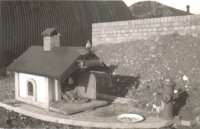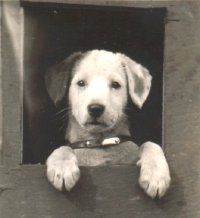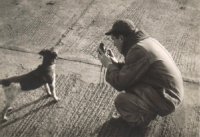 |
Animal and Mascot Photographs |
Personnel
Mission Reports
Vehicles
Thunderbird Photos
www.flickr.com
|
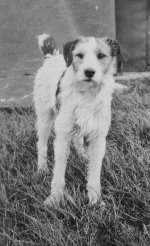 AIRMAN HOMER - Canine Aviator
AIRMAN HOMER - Canine AviatorAirman Homer, Serial #1102586(A) — This photo was taken while "on duty" with the 358th BS at Molesworth in 1945. "Reliable sources" tell us that Homer was awarded the Air Medal for participating in five combat missions in January and February 1945, though we have been unable to confirm this with official records. We have been assured that Homer was never actually at the controls during the bomb runs. Homer's missions were to Kassel, Cologne, Kall, Mannheim and Berlin.
The human members of Homer's Crew were: 2Lt Lawrence E. Poole (P), 2Lt Harley E. Cannon (CP), 2Lt Harold S. Smith (N), Sgt Rayford E. Pullen (E), Sgt Marvin L. Hoke (R), Sgt Charles K. Morrill (BT), Sgt Donald P. Smith (WG), Sgt Harry D. Kinsland (WG) and Sgt Beryl E. Kindred (TG).
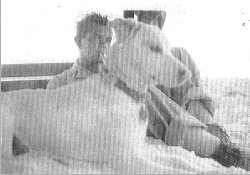 RECON - 427th Mascot
RECON - 427th Mascot
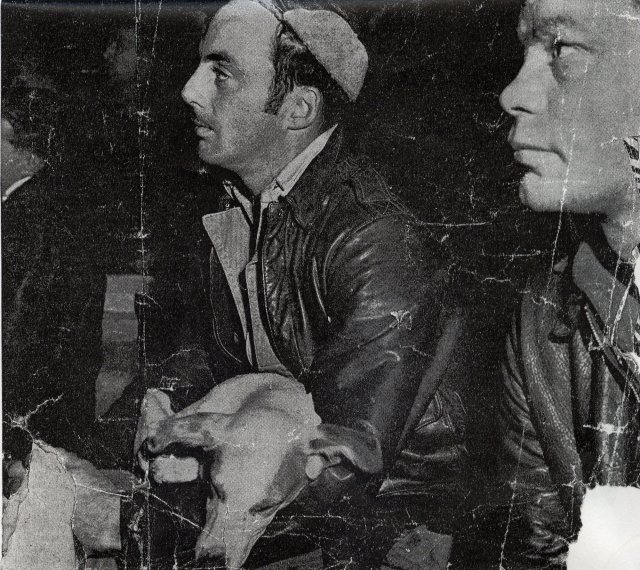
S/Sgt Robert K. Sink at a briefing with a dog that may be Recon
[photo from Collier's Magazine, November 27, 1943 - courtesy of Rosemary Sink Turner]
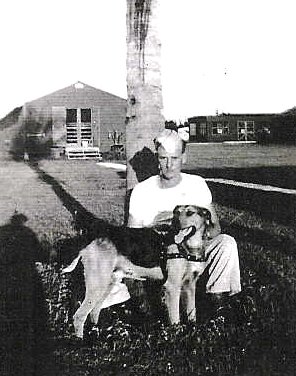 JOCKO - 1199th MP Company Mascot
JOCKO - 1199th MP Company Mascot
Military Policeman Paul O. Harmon (shown with Jocko) was stationed with the 1199th MP Company at Bushey Park, England. One day he was on guard duty at the gate which led to his barracks. An Englishman came up to him with a big English Airedale dog and asked him to take the dog. He said he could not feed him and was given a no answer. The Englishman then replied, with tears in his eyes, that the dog would have to be destroyed. Paul Harmon then gave in and said that he would take the dog whose name was Jocko. Paul thought that after he had fed Jocko he would not stay - but he did. Whenever he couldn't find Paul Harmon he would be the first in the chow line. While at Bushey Park, Jocko would chase the deer. The deer would run and hit the fence and break their necks or legs. The MPs had to report it because they were the Queen's deer. This was a lot of trouble, paperwork and investigations. The next deer being chased by "Jocko" hit the fence, broke his leg, and the MPs had venison in their mess hall. Shortly after this incident Paul Harmon and Jocko were transferred to Molesworth. The 1199th MP Company personnel, and a lot others at Molesworth, got to know and like the new M.P. Mascot. Jocko remained with the MPs all during their stay and Molesworth and went with Paul Harmon to Africa and USA after the 8th AF hostilities ended. No matter where Paul Harmon and Jocko went, some G.I. would recognize Jocko and say "There is that M.P. Dog from Molesworth." Paul Harmon and Jocko, after being given a 30 day furlough near Paul's Pittsburgh, PA home, were discharged on December 18, 1945. Then they signed up for another three year enlistment at Mather Field, CA.
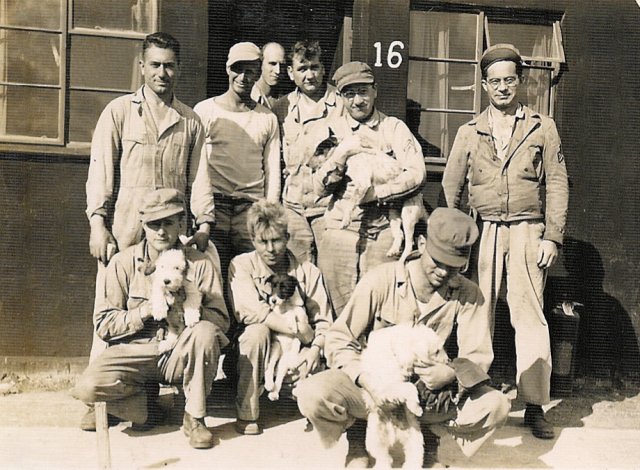
359th Ordnance Personnel with Dogs - Demolition, Fuzzy, Scotty and Joe
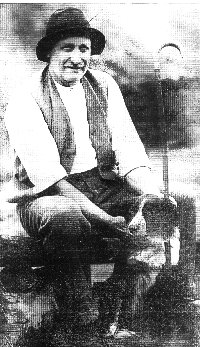 SHEILA - A British Dog Hero [Crash Site Photos]
SHEILA - A British Dog Hero [Crash Site Photos]
On 16 December 1944, Thirty-nine 303rd BG aircraft flew as the 41 CBW-A Group to attack Ulm. The formation was recalled due to adverse weather conditions and turned back at 1005 hours over England. Bombs were jettisoned in the North Sea before the aircraft returned. Some of the aircraft landed at an RAF airfield at Kirmington, England.
One of the 303rd BG(H) B-17s became lost and crashed into a mountain southeast of Edinburgh, Scotland. The B-17, #44-6504 (No Name), 360BS, was on its third mission. After the mission was recalled, the Fortresses broke formation on the return route and were ordered to land separately at various Bases to avoid mid-air collisions. The Pilot, 2Lt George A. Kyle, executed a 180 degree turn back toward England and, at the same time, began his descent. On several occasions he requested headings, only to discover that they were coming from German transmitters. Twice he found himself heading toward France. He descended to 3,000 ft., attempted to find a hole in the clouds, and retained his bombs, not knowing where they might drop. At 1315 hours, the west hill of the Cheviot at 2,600 ft. one of the highest points in England, suddenly loomed out of the snow. His B-17 struck the mountainside and skidded across a bog, with the peat absorbing some of the impact.
F/O Fred Holcombe, Navigator, and Sgt Frank R. Turner, Togglier, were instantly killed. Fires erupted from the ruptured hydraulic and fuel lines, but the RDX bombs did not explode. Lt Kyle was pulled from the aircraft by his copilot, F/O James H. Hardy. The cockpit crewmen, Kyle, with a broken jaw, Hardy, and Sgt E. C. Schieferstein, the engineer, wandered down the hill, found a farm house, and were taken to an RAF first aid station near Berwick.
The four men in the back of the aircraft all suffered minor injuries. Sgt J. A. Berly, radio operator, tried to put out the bomb bay fire, but his foot became entangled in the plywood floor and a mass of peat. Waist Gunner, Sgt William R Kaufmann, who had been knocked unconscious during the crash, regained consciousness in time to pull Sgt Berly free and to assist Sgt George P. Smith, ball turret gunner, from the plane. The three men found tail gunner Sgt Howard F. Delany wandering around in deep snow, bleeding from a severe head wound. They left the aircraft and found shelter in a ditch 100 yards away. After several hours, Sgt Smith felt a dog licking his face. The dog's barking brought two shepherds, John Dagg and Frank Moscrop, to the ditch. They had been searching in the storm with Dagg's collie Sheila for survivors. Sheila led the group through the blizzard to Dagg's cottage. The B-17 blew up with a window-shattering explosion just as they reached the cottage. Dagg's daughter ran two miles through the storm to summon help by telephone. Later that night the four sergeants were taken to the same RAF hospital that treated the other crewmen.
Sequel:
- 2Lt George A. Kyle, Jr., pilot - was invalided back to the US in April, 1945.
- F/O James H. Hardy, copilot - returned to flying and completed 30 missions. He was awarded the Soldier's Medal for rescuing Lt Kyle.
- F/O Fred Holcombe, navigator, and Sgt Frank R. Turner, togglier, were buried at the American Cemetery at Cambridge, England. In 1946 Sgt Turner's mother wrote to the shepherd, John Dagg, and thanked him for his efforts. She asked that if the collie Sheila had puppies, she would like to buy one. A few months later the RAF flew Sheila's first puppy, named Tibbie, to South Carolina. Tibbie lived for 11 years as the adopted town pet of Columbia, SC.
- Sgts Schieferstein, Berly, Kaufmann, and Delany returned to flying status and flew another 10 or 11 missions. Sgt Kaufmann was awarded the Soldier's Medal for his rescue of Sgt Berly.
- Sgt George P. Smith, ball turret gunner, collapsed on a train platform in London with spinal meningitis while on a rest leave. At the 150th Station Hospital, he was pronounced dead and was taken to the morgue. While awaiting autopsy, Maj. Hill, a doctor, noticed that Smith's dog tags indicated that he was from Louisville, Kentucky, Maj. Hill's hometown. The doctor decided to listen for Smith's heart beat once more, detected a faint heart beat, and revived him.
- John Dagg and Frank Moscrop, the shepherds, were awarded the British Empire Medal in June, 1945, in ceremonies on the Cheviot. This was Dagg's second medal for rescue efforts during the war.
- Sheila, the collie, was awarded the Dickin Medal for animal heroism, the first civilian dog to be awarded this medal.
- Summer, 1967 - Members of the St. Michael's Church Choir Club, Alnwick, England, unearthed portions of aircraft #44-6504 on the Cheviots's mountainside where it crashed, and found two bombardier microswitches. The switches were sent to the Honeywell Microswitch Division, Freeport, Illinois, where tests revealed that one of the switches was still in working order. The boys in Alnwick, called "The Reivers," an ancient term for border raiders, embarked on the arduous task of building a memorial. One propeller freed from the wreckage was planted in concrete pointing toward the grave of the buried bomber. A memorial plaque was installed that reads: "Erected by the St. Michael's Church Choir Club, The Reivers, to the men of the U.S.A.A.F. who fought for our freedom,1941-1945."
- June, 1968 - Sgt Turner's son, Roderick Turner Merritt, 23, of South Carolina, the seven crew survivors, high ranking military guests - including the retired Generals Spaatz and Eaker, and Air Vice Marshall David Crowley-Milking, RAF Air Attache in Washington, DC - and a Honeywell vice president made a 3,500-mile impulse journey to England to participate in the dedication of the memorial. They took part in the ceremony by slipping a blue and yellow drape from the memorial. The vicar of St Michael's Church, the choir boys, and others, also participated in the memorial ceremony high atop the mountain. It was climaxed by a flyover of four US F100 fighters and the sounding of "The Last Post" by a bare-headed Reiver bugler.
The mountainside plaque was vandalized and no longer exists. Large aircraft parts remain at the crash site. On 26 December 1994, on the fiftieth anniversary of the crash, two F-15 Jets from the 48th Fighter Wing at RAF Lakenheath made a 1315 hours flyover at the crash site - the exact hour of the crash. The flyover was viewed by a group of citizens from Wooler, who hiked to the crash site. Pupils from the Glendale Middle School in Wooler lined up on a former airfield to form the figure "50" that was seen by the flyover pilots. A new monument, dedicated to all airmen who lost their lives on the Cheviot Hills, was dedicated on 19 May 1995 at the Sutherland Hall entrance to College Valley. A display of the crashes was placed in the Wooler Library. The ceremony was attended by crash survivors George Kyle and Joe Berly and Frank Moscrop, one of the rescue shepherds.
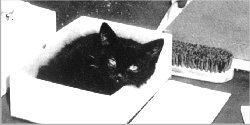 HYPO - The Photo Lab Cat
HYPO - The Photo Lab Cat
Little is known about Hypo the Photo Lab Mascot, other than she was a good mouser.
